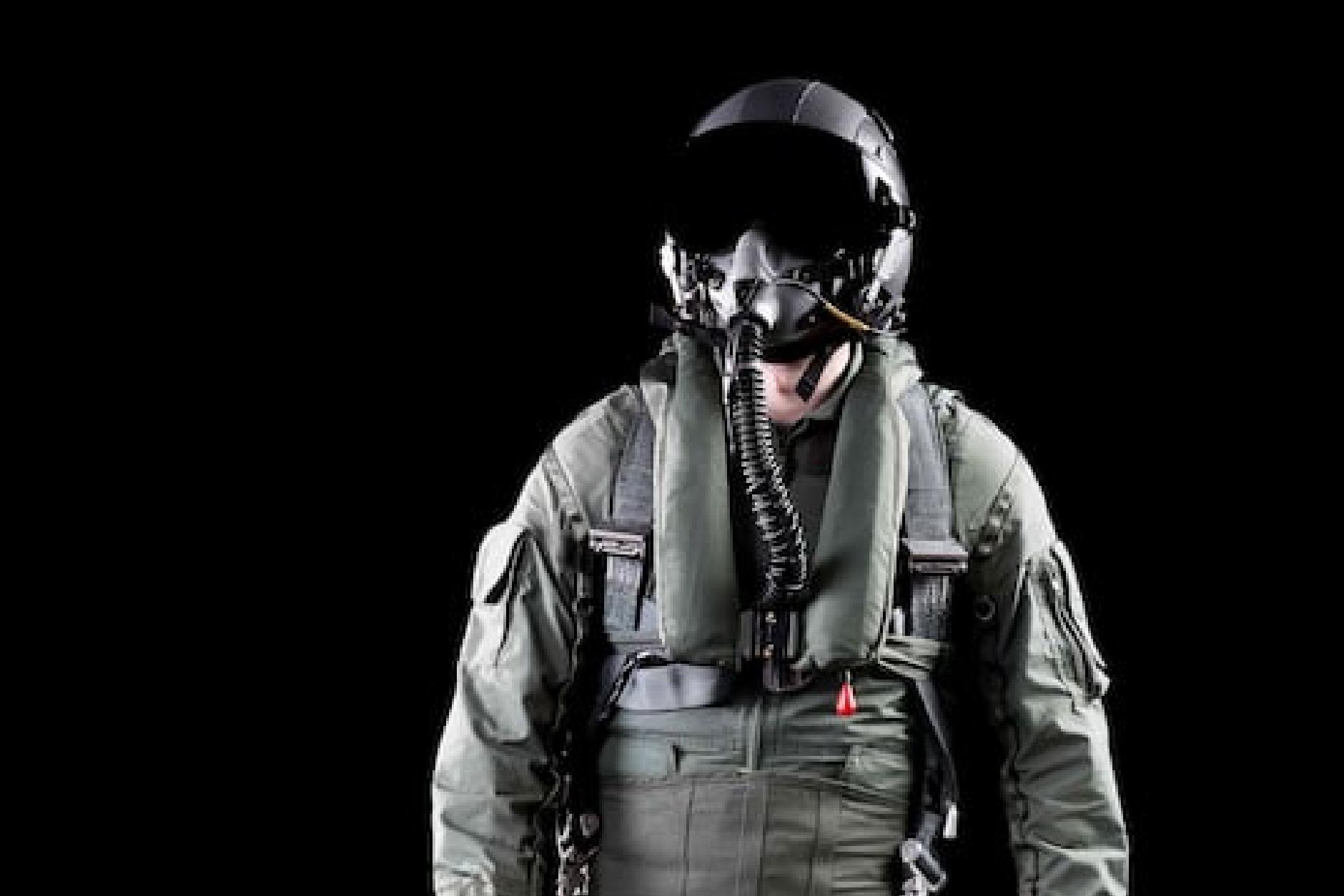Understanding Anti-G Suit Physiology

Table of Contents
- Introduction
- G-Forces and the Human Body
- Physiological Effects That Lead to G-LOC
- How Anti-G Suits Work
- Anatomy of an Anti-G Force Suit
- Why High-Quality Manufacturing Matters
- Applications Beyond the Cockpit
- Working With Vinyl Technology, a Manufacturer You Can Trust
Flying a fighter jet at full throttle looks impressive from the ground. Inside the cockpit, though, things get complicated. One of the biggest challenges pilots face is the force pulling their blood in the wrong direction. Positive g-forces shove everything downward, including the blood meant for the brain. That’s what causes tunnel vision, blackouts, and full-on G-LOC — g-force induced loss of consciousness.
The body alone can’t handle that kind of pressure. It needs help from gear built to fight back. That’s where the anti-G suits come in. These suits use air pressure to squeeze the right muscles, keeping blood where it belongs during high-speed maneuvers. The tech isn’t new, but the engineering behind it keeps getting better. Good thing too — those extra seconds of alertness can make the difference between staying in control or spiraling into trouble.
G-Forces and the Human Body
Gravity plays dirty at high speed. Positive g-forces — the kind pilots experience when pulling tight turns or accelerating rapidly — yank blood toward the lower half of the body. That leaves the brain scrambling for supply. Instead of a steady flow of oxygen-rich blood, the head ends up with not much of anything. The result? Vision starts to fade, thinking slows down, muscles go limp, and then… lights out.
Without some kind of pressure garment, the average human can only handle about 4 or 5 Gs before G-LOC sets in. That’s G-induced loss of consciousness. It happens fast — sometimes in under five seconds — and recovery isn’t instant either. A pilot who blacks out mid-flight can be unconscious for 10 to 30 seconds, and even after waking up, may need a few more to think clearly. That lag can get deadly in combat or training. Aircraft don’t wait around.
Blood flow to the brain drops off as the heart struggles against gravity. The faster and longer the G-load, the quicker the drop. Tunnel vision hits first. Then gray-out. Then blackout. Full G-LOC lands last, and it can hit like a sucker punch. No warning, no slow fade — one second the pilot’s flying, the next they’re slumped over and tumbling at 600 knots.
Physiological Effects That Lead to G-LOC
The body wasn’t built to fly. At least not the way fighter pilots do it. Under positive Gs, gravity grabs hold of the blood and drags it toward the feet. Without any countermeasure in place, that pressure pulls blood out of the brain and into the legs and abdomen. It doesn’t take long before the effects start stacking up.
As blood shifts downward, cerebral blood pressure drops. That means less oxygen hitting the brain — not great when you’re trying to keep control of an aircraft screaming through the sky. Even before total blackout, the signs start creeping in. Vision narrows to a tunnel, color drains, and reaction time stretches out. That’s the point where mistakes happen. Full loss of consciousness is usually right behind.
The heart tries to fight back, but it’s working against a stacked deck. It pumps harder to push blood upward, while the Gs are working just as hard in the opposite direction. The lungs don’t catch a break either. Diaphragm movement becomes limited under pressure, and oxygen uptake falls. Put that all together, and the body enters a state it can’t sustain. Something has to give — and it’s usually the brain.
How Anti-G Suits Work
An anti-G suit doesn’t look like much at first glance — just a set of pants with a few extra parts stitched in. But inside, there’s a pressure system working hard to keep pilots awake and functioning under extreme acceleration.
The suit fights g-forces using mechanical compression. As the aircraft pulls Gs, air gets pumped into bladders built into the fabric. These bladders swell and apply pressure to key areas of the body. That pressure squeezes the muscles and blood vessels in the abdomen, thighs & calves, which slows blood from pooling where it shouldn’t. Instead of rushing to the lower body, blood stays up where the brain can use it.
The bladder system is made from polyurethane-coated nylon and fits inside an outer layer of aramid cloth. It’s not some loose wrap either, it presses in exactly where it needs to. The suit connects to the aircraft’s onboard anti-G system through a hose. As G-load increases, the plane feeds air into the suit in real time. More Gs mean more pressure. The whole setup reacts fast, holding the pilot together through the roughest turns.
Anatomy of an Anti-G Force Suit
Anti-G suits need to fit like a second skin. Every piece has a purpose, and nothing gets added unless it earns its place.
The outer shell uses aramid cloth — a tough, fire-resistant textile designed to survive harsh flight conditions. It holds everything in place and protects the inner bladder system without adding bulk. Underneath, the bladder is made from polyurethane-coated nylon. That’s the part that inflates during high-G maneuvers and squeezes the body to keep blood up top.
Six lacing zones help dial in the fit. Fasteners at the waist and legs make the suit easy to put on without sacrificing pressure control. A built-in hose links directly to the aircraft, feeding pressurized air to the suit exactly when the Gs hit. The pockets on each leg? They’re not for snacks — they zip up tight to keep gear secure and out of the way during high-speed operations.
Suits come in seven different sizes. Fit matters. A loose suit can’t apply pressure where it counts, and a tight one cuts off circulation. These suits are designed to work with fighter jets like the F-16, F-15, A-10 & F-18. No guesswork, no generic fits — each setup matches the aircraft and mission profile.
Why High-Quality Manufacturing Matters
At 9 Gs, every detail has to work exactly as designed. A sealed bladder that holds pressure, stitching that stays tight under force, and materials that don’t stretch or tear — all of it matters. These suits protect pilots who are seconds away from losing consciousness if something fails.
Compression has to hit the right zones. The bladder expands over the abdomen, thighs & calves with air fed from the aircraft’s onboard system. That air needs to move fast, and the materials have to respond without delay. Any weak seam or slow inflation creates a gap in protection. Blood drops out of the brain and down to the legs, and the pilot goes out cold.
Military-grade anti-G suits follow a specific standard: MIL-DTL-83406D. Every part of the suit — the outer shell, the bladder system, even the lacing zones — must meet that requirement. Fit, pressure handling, and durability all get tested under real conditions. No piece gets approved without passing those evaluations.
Once pressure builds, there’s no time for second chances. That’s why every stitch, weld & seam must hold its shape under load. These suits cycle through G-force repeatedly. Long flights, multiple missions, pressure up, pressure down. Weak construction won’t survive that kind of beating. High precision and consistent quality are what make the suit perform when it counts.
Applications Beyond the Cockpit
Anti-G suit tech doesn’t stop at fighter jets. The same pressure principles show up in gear used for space missions. Astronauts face different challenges, but their bodies still need help managing pressure shifts and fluid movement during launch, orbit & re-entry. Pressure garments help keep circulation stable when gravity disappears or suddenly comes roaring back.
Aerospace contractors rely on this type of gear to protect personnel in environments that punish the human body. Spacecraft cabins, escape systems, and even experimental test rigs all demand custom pressure solutions. These aren’t off-the-shelf problems. Each use case comes with its own pressure points — literally.
Military systems keep evolving, and the demands on pilots and crew get more intense. High-speed craft, sudden maneuvering, tight cabin constraints — the suits have to match the mission. Pressure garments do more than just keep people conscious. They let them operate under conditions that would otherwise knock them out. That kind of protection turns into performance, and performance keeps people alive.
Working With Vinyl Technology, a Manufacturer You Can Trust
Anti-G suits are mission-critical garments that have to perform under extreme stress, again and again. That’s why accuracy, consistency & turnaround speed matter.
We manufacture anti-G suits for aerospace and defense buyers that can’t afford failure. Our process uses RF welding and precision industrial sewing to meet demanding tolerances. Nothing gets assembled until every measurement, material spec and seal point checks out.
Manufacturers and commercial sewing services providers must hold Qualified Producers List (QPL) status. Companies have to maintain production standards, pass periodic inspections, and comply with specs like MIL-DTL-83406D.
At Vinyl Technology, we are a custom sewing contractor who can produce suits like the CSU-13B/P and CSU-15A/P for high-performance aircraft platforms. Our team works with clients to meet specific mission needs — including sizing, material choices & compatibility requirements. If the job calls for custom textile or polymer film fabrication, we’ve done it. That’s been our specialty for over 40 years.
To start a conversation about your program, call us at 626-443-5257 or request a quote. We’ll walk through the details with you and figure out how to meet your requirements.

